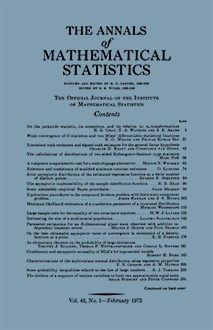Abstract
Let $X_1, X_2, \cdots$ be independent and identically distributed random variables with possible values that are integers whose differences have g.c.d. one. Assume the m.g.f. of $X_1$ exists in an interval about 0, let $a$ be any number such that $E(X_1) < a < \sup X_1$, and let $\phi(a, t) = Ee^{t(X_{1-a})}$. There exists a unique value $t^{\ast}(a)$ of $t$ which minimizes $\phi(a, t)$ with respect to $t$; write $m(a) = \phi\lbrack a, t^{\ast}(a)\rbrack$ and $z = e^{-t^{\ast}(a)}$. Let $Y_1, Y_2, \cdots$ be independent and identically distributed random variables such that $Y_1$ and $X_1$ have the same range and $\Pr(Y_1 = x) = \Pr(X_1 = x) \cdot e^{t^{\ast}(a)(x-a)}/m(a)$, and let $\mu_2 = \sigma^2, \mu_3, \mu_4$ be central moments of $Y_1$. We show that $\Pr \{X_1 + \cdots + X_n = na\} = \lbrack m(a) \rbrack^n \Pr \{Y_1 + \cdots + Y_n = na\}$, and use this to establish the approximation $\Pr \{X_1 + \cdots + X_n = na\} = \pi^{\ast\ast}_n\lbrack 1 + 0(n^{-2})\rbrack$, where $na$ is a possible value of $X_1 + \cdots + X_n$ and $$\pi^{\ast\ast}_n = \frac{\lbrack m(a)\rbrack^n}{\sigma\sqrt{2\pi n}} \big\lbrack 1 + \frac{1}{8n} \big(\frac{\mu_4}{\mu^2_2} - 3 - \frac{5}{3} \frac{\mu^3_2}{\mu^3_2}\big)\big\rbrack.$$ Similarly we find that $\Pr \{X_1 + \cdots + X_n \geqq na\} = \Pi^{\ast\ast}_n\lbrack 1 + 0(n^{-2})\rbrack$, where $$\Pi^{\ast\ast}_n = \pi^{\ast\ast}_n \cdot \frac{1}{1 - z}\Bigg\{1 - \frac{1}{2n}\Bigg\lbrack\frac{(z\mu_3/\mu_2) + z(1 + z)/(1 - z)}{(1 + z)\mu_2}\Bigg\rbrack\Bigg\}.$$ We provide some numerical illustrations of the accuracy of these approximations, and give a conjectured analog of the leading term of $\Pi^{\ast\ast}_n$ for nonlattice variables.
Citation
David Blackwell. J. L. Hodges Jr.. "The Probability in the Extreme Tail of a Convolution." Ann. Math. Statist. 30 (4) 1113 - 1120, December, 1959. https://doi.org/10.1214/aoms/1177706094
Information





